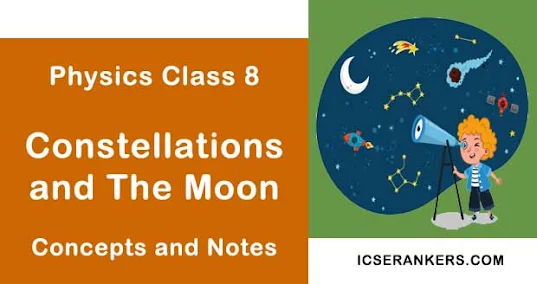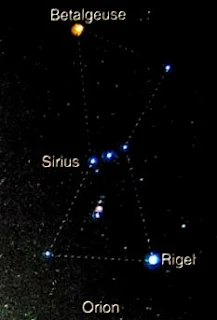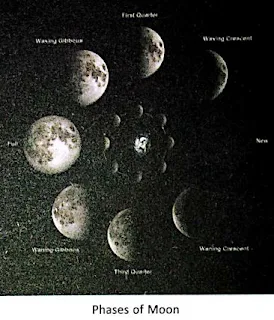Constellations and The Moon- Physics Guide for Class 8
Information about Constellations and The Moon
Title | Constellations and The Moon |
Class | Class 8 |
Subject | Class 8 Physics |
Topics Covered |
|
Constellations
A close and careful observation of the stars, on a clear night, reveals that some of these stars appear to form some kind of patterns that appear to resemble some familiar shapes. Such a group of stars is known as constellation.
- A constellation is a group of stars that appear to form some recognisable pattern, or shape, in the sky.
Some Prominent Constellations
When we spot three bright stars in a row on a winter evening, we exclaim, 'Oh! that's part of the Orion!'
Orion is one of the magnificent constellations in the sky. It has seven bright stars. Four of these appear to be arranged in the form of a 'quadrilateral' and the other three form a straight line in the middle.
One of the largest stars, known as Betalgeuse, is situated on one corner of this 'quadrilateral' while another bright star, called Rigel, is located on its opposite corner.
- The Big Dipper is another prominent constellation.
- It is made up of seven stars in the northern celestial hemisphere.
- It is also known by the name 'Ursa Major' (or the Great Bear).
- In this constellation, the two stars, at the top, are called pointers. This is because the line joining them points in the direction of the Pole Star.
- Another well-known constellation is the Ursa Minor or Small Dipper.
- This also has seven prominent stars in it.
- Pole star lies on the handle tip of this constellation.
Both the Ursa Major and the Ursa Minor constellations are usually visible during the spring season.
- Cassiopeia is another prominent constellation in the northern sky.
- It is visible during winter in the early part of the night.
- It looks like a distorted form of the letter, W or M.
The Moon
The moon, our nearest neighbour in space, is a natural satellite of the earth (A satellite is a relatively smaller heavenly body that revolves round a much heavier body). It has no air or water on it. It does not have any light of its own. Its observed silvery glow is only due to the light of the sun reflected by its surface.
We all observe that the shape and size of the front (or bright) part of the moon appears to change gradually everyday.
- It takes nearly 29.5 solar days for the moon to make one complete revolution around the earth.
- Although one half of the moon (the half facing the sun) is always illuminated by the sun's light, the 'lighted up' portion, of the moon appears to change shape (as viewed from earth). This is due to changes in the relative position of the earth, the sun and the moon.
- During the first half of the moon's orbit, the moon's apparent size grows (waxes).
- During the remaining half of its orbit, the moon appears to decrease (wanes) in size.
- On a full moon day, the earth lies in between the moon and the sun. On this day, the full face of the moon is visible to us.
- On a new moon day (nearly fifteen days after the full moon day), the moon is on the 'other side' of the earth, hence, we cannot see it.
- On the days following the new moon day, the illuminated part of the moon (that is visible from the earth) appears crescent in shape.
- The size of this illuminated part goes on increasing day by day until its full face becomes visible again on the full moon day.
- These appearances of moon on different days, are known as the phases of the moon.
The Moon's Surface
In 1969, the American astronaut, Neil Armstrong landed on the moon for the first time; he was followed by Edwin Aldrin. They found the Moon's surface to be dusty and barren. Crates, up to hundreds of kilometres wide, cover its surface. It also has large number of mountain ranges, valleys and lava plains. The Moon does not possess any atmosphere and water; thus, there are no weather changes on it. As there is no atmosphere to trap heat, the temperature on the Moon is extreme, ranging from 100°C at 'noon' to — 173°C at 'night'.
Some Important Points
- The 'shapes' of the 'constellations' have been 'defined' through 'human imagination'. Poets, farmers and astronomers have made up these 'shapes' over the past 6,000 years. Their real purpose (for imagining these stellar installations) was to help them identify different stars and their locations in the sky at different times of year. Constellations have been used as memory aids.
- The star Sirius, which is the brightest star in the sky, is located close to Orion. To locate Sirius, imagine a straight line passing through the three middle stars of Orion. Look along this line towards the east. This line will lead to a very bright star. It is Sirius.
- A constellation does not have only 5-10 stars. It has a large number of stars. However, we can see only the bright stars in a constellation with the unaided eye. All the stars which make up a constellation are not at the same distance. They are just in the same line of sight in the sky.
- It is interesting to note that the footprints left by Apollo astronauts may last for centuries on the surface of moon. This so because there is no atmosphere, or winds on the moon. Chandrayan-I is India's first unmanned lunar probe. It was launched by Indian Space Research Organisation (ISRO) in October, 2008 and operated till August, 2009. The mission was a major boost to Indian space programme as India researched and developed its own technology in order to explore the moon.
- On 14 November 2008, the Moon Impact Probe (MIP) crash-landed on the lunar surface, making India the fourth country to place its flag on the Moon. The MIP was one of eleven scientific instruments on board at Chandrayan-I. After scientific analysis of the data received from MIP, ISRO confirmed presence of water on lunar soil.







